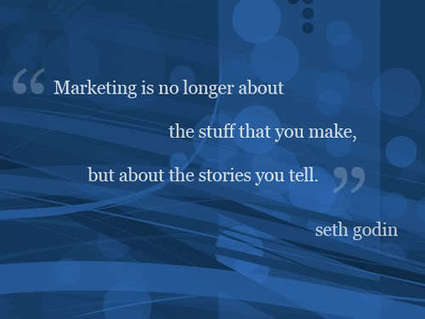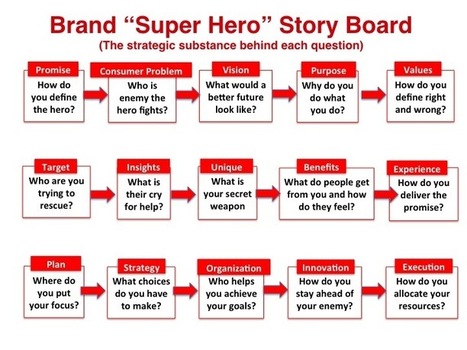This is a Change This PDF that you can view here:
http://changethis.com/manifesto/98.01.StoryWars/pdf/98.01.StoryWars.pdf ;
I'm curating this because I like it and I don't like it -- and it is worth taking a look at the assumptions going on in this piece so we can get really smart.
This piece was put together by Jonathan Sachs, author of Winning The Story Wars. Sachs comes from the world of marketing and branding and this is reflected in his point of view.
Let's get what I don't like out of the way so I can chat about what I do like. Here is what puts my teeth on edge:
1. Sachs states that "we live in a world that has lost its connection to traditional myths and we are now trying to find new ones..." Welllllllll, if your slice of reality is the Hollywood, advertising, and branding world it is easy to get sucked into this notion. But we know from Jung, other psychologists, Folklorists, Anthroplogists, and neuroscience how this is not true. There is great irony in this "myth" that Sachs is perpetuating.
2. We are engaged in a war. Hmmmmm. Well, for millenium people have wanted to gain the attention of other people -- so nothing new there. Is this a war? Could be. But if we are wanting to employ the power of storytelling to find solutions and create change as Sachs advocates, then war does not speak to the greater good but instead speaks to winners and losers where ongoing resentment is inherently built in. That sounds like the perpetuation of war -- same old same old.
3. Sach's relationship to storytelling is still at the transactional level -- I'll tell you a story and you'll do what I want. While what he really wants it seems is storytelling at the transformational level. That requires a different mind-set and different story skills -- deep listening, engagement, story sharing, etc. And he completely ignores the relational level of storytelling.
4. Reliance on the Hero's Journey as the only story archetype to follow. Well, that's a narrow slice of reality and one geared towards youth. Yet other story archetypes are desperately needed: King/Queen, Trickster, Magician for example in order to affect change.
5. As a result, his 10 simple strategies stay at the transactional level with a few geared towards transformation (figure out what you stand for, declare your moral, reveal the moral). Now any great professional storyteller will tell you these that I've mentioned are essential for any compelling storytelling session. So they land in both worlds of transactional and transformational storytelling.
OK -- on to what I do like!
If you want to be heard, you'd better learn to tell better stories. The solutions to our significant problems these days depends on our ability to tell great stories and inspire people to think differently. Storytelling does not take long to learn, but it does take a lifetime to master, Know what a story is and is not Our abilitiy to disseminate stories is greater now than in the past -- because of technology. That is just a reminder to expend your use of different channels in sharing your stories that are now available to us.
Enough! Go read this piece yourself and decide what you think about it. It's a quick read.
This review was written by Karen Dietz for her curated content on business storytelling at www.scoop.it/t/just-story-it ;



 Your new post is loading...
Your new post is loading...












![The Five Essential Elements of a Great Company Story [Infographic] | MarketingProfs | How to find and tell your story | Scoop.it](https://img.scoop.it/mZz17xjbRSkT1VdFp1NerDl72eJkfbmt4t8yenImKBVvK0kTmF0xjctABnaLJIm9)



















Help your leaders build their storytelling skills. They can be one of the most effective communication channels you have.
"Paying attention to the middle three element outlined above (Platform, Person and Plot) will ensure your story is engaging and captivating and something people will understand and want to listen to until the end. Paying attention to the first (Premise) and fifth (Point) elements will ensure your story is strategic: that it’s relevant to the workplace situation in which you’re telling it and that the audience is rewarded with something meaningful in hearing it."